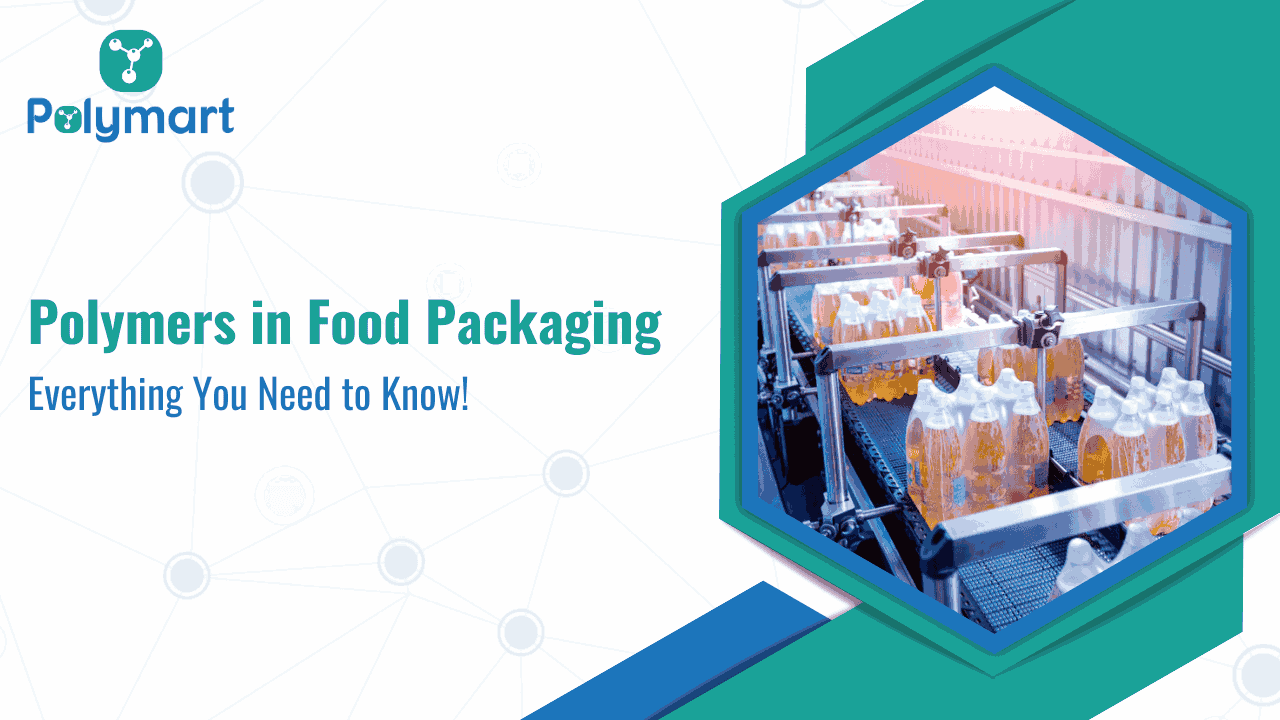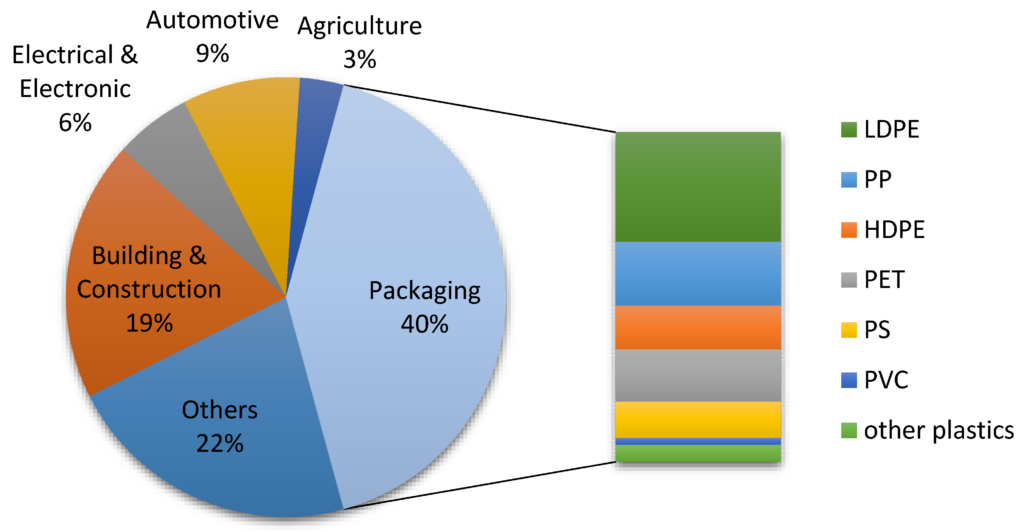
The need for plastic raw materials for the manufacture of food and beverage packaging has skyrocketed. With almost one-third of the worldwide packaging market, the food packaging market is by far the largest application segment in the packaging business. The worldwide plastic film market’s food packaging segment was valued at USD 12 billion.
The way we store, transport, and eat food has evolved as a result of the usage of plastic polymers in food packaging. However, understanding the polymer material remains crucial for an effective food-packing process.
In this comprehensive article, we will look at the global use of polymers for food packaging, including their various types, qualities, and applications, as well as the impact the polymers have on food safety and sustainability.

Polymers for Food Packaging
Polymers are part of everything we do on a daily basis, from opening a can of juice in the morning to tearing off a packet of chips for a midnight snack. Every food item is carefully wrapped and packaged with plastic polymers to maintain safety standards and ensure integrity.
Polymers are huge molecules composed of recurring structural units generated by the joining of monomers. Polymers are used to make a variety of packaging materials for food packaging, such as films, containers, wrappers etc.
Polymers used in food packaging are carefully chosen for their mechanical strength and flexibility, as well as their ability to act as a barrier to external factors such as moisture, oxygen, and light.
Types of Polymers Used in the Food Packaging Sector:
PP (Polypropylene)
Density: 0.890-0.910 g/cm3
Melting Point: 130-171°c
Polypropylene has a high melting point, good transparency, and excellent barrier properties. It offers good resistance to heat, moisture, and chemicals. PP is commonly used in food containers, cups, and packaging films due to its ability to withstand high temperatures during packaging processes.
HDPE (High-Density Polyethylene)
Density: 0.930–0.970 g/cm3
Melting point: 120–140°C
HDPE is a thermoplastic polymer made up of petroleum. It is known for its high strength-to-density ratio, excellent moisture resistance, and exceptional chemical resistance. It provides a good barrier against moisture vapour transmission. HDPE is commonly used for packaging milk, juice, and other beverages.
MDPE (Medium-density Polyethylene)
Density: 0.926–0.940 g/cm3
Melting Point: 126 – 128 °C
MDPE can be produced by chromium/silica catalysts, Ziegler-Natta catalysts, or metallocene catalysts. It is not as commonly used as the other forms of polyethylene flexible plastic sheeting. MDPE has a good stiffness-to-toughness ratio, making it ideal for packaging baked goods, heavy-duty produce bags, wash bottles and dispensing bottles.
LDPE (Low-Density Polyethylene)
Density: 0.91–0.94 g/cm3
Melting point: 115°C
LDPE is a cost-effective and flexible polymer material with excellent moisture barrier properties. It is a thermoplastic polymer that is transparent, so it allows food contents to be easily viewed. Food manufacturers rely heavily on the PolyMart Buyer App to buy LDPE polymers online for the production of high-quality squeezable food bottles, bread and frozen food packaging, and flexible lids.
LLDPE (Linear Low-density Polyethylene)
Density: 0.915–0.930 g/cm3
Melting Point: 120-130°c
LLDPE exhibits high tensile strength, puncture resistance, and stretchability. It has excellent sealing properties and is commonly used in food packaging films for frozen products, especially in applications where high mechanical strength is required.
PVC (Polyvinyl Chloride)
Density: 1.30-1.45 g/cm3
Melting Point: 75-100°c
PVC is traditionally used in food packaging due to its excellent clarity and barrier properties. However, due to environmental concerns, its usage in food packaging has decreased. PVC is still used in some food packaging applications where its specific properties are required.
PET (Polyethylene Terephthalate )
Density:1.3-1.4 g/cm3
Melting Point: 250-270°c
PET is a strong and lightweight polymer material with excellent gas barrier properties. It is widely used for beverage bottles, food containers, and packaging films. PET provides exceptional resistance to oxygen and carbon dioxide, making it ideal for extending the shelf life of packaged food products.
Importance of Polymers for Food Packaging
Polymers play a major role in food packaging because of their remarkable barrier properties. By ensuring the freshness, flavor, and overall quality of the food, this novel addition to preservation serves to extend the shelf life of packaged food. They are used to creating creative packaging solutions that are perfect for packaging a variety of food products. Because of the visually appealing packaging, this outcome-driven business strategy drove up revenue for the food packaging and manufacturing company. Furthermore, by meeting certain criteria, polymers ensure that the material is inert in relation to the food contained.
Benefits of Using Polymers in Food Packaging:
- Protect food from microbial attack.
- Maintain the freshness of the product.
- Increase product shelf-life.
- Good thermal & mechanical properties
- Ease of making plastic film
- Facilitate the creation of various packaging styles.
- Cost-efficient solution
How to Buy Polymers for Food Packaging?
While the market is flooded with polymer grades, it might be difficult to identify the right one for your particular application. We at PolyMart recognize the difficulties that buyers and sellers of polymers face, which is why we are here. PolyMart, a leading polymer distribution company in India, has come across a groundbreaking approach to ensure seamless polymer procurement. With the support of the PolyMart Buyer App, customers can easily connect with reputable PolyMart suppliers and explore a vast selection of polymer grades. They can also stay informed about daily price trends, enabling them to make well-informed decisions.
Download the PolyMart Buyer App Here:
ABS Polymers: An Overview of their Uses and Benefits
[…] have an impact on our lives. Polymers can be used in an innumerable number of industries such as food packaging, construction, and […]
Tips for Selecting the Right Polymer Material Easily
[…] of flammability and smoke emission may also be enforced, depending on the use case of a product. Polymers used in food packaging also have strict regulations to ensure the food is not contaminated and the consumers are […]
Comments are closed.